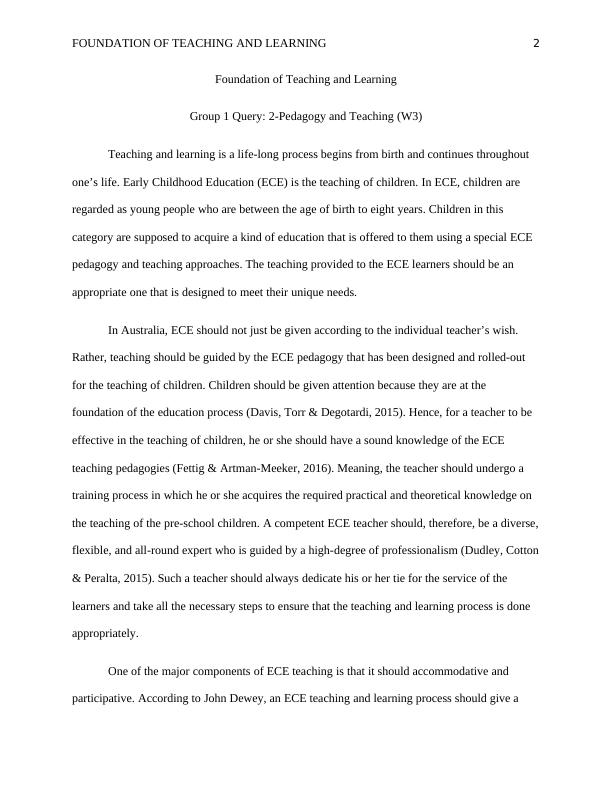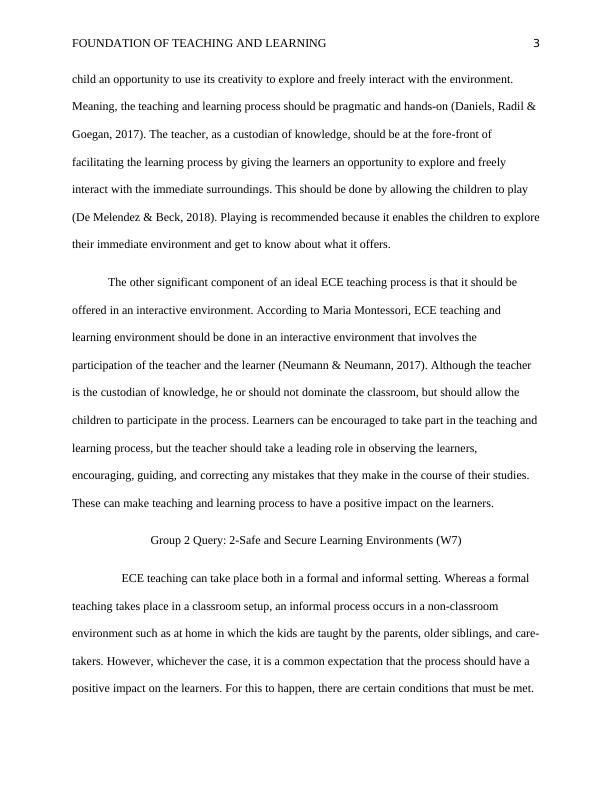Foundation of Teaching and Learning
Added on 2023-01-17
8 Pages2303 Words27 Views
FOUNDATION OF TEACHING AND LEARNING 1
Foundation of Teaching and Learning
Name
Institution
Foundation of Teaching and Learning
Name
Institution

FOUNDATION OF TEACHING AND LEARNING 2
Foundation of Teaching and Learning
Group 1 Query: 2-Pedagogy and Teaching (W3)
Teaching and learning is a life-long process begins from birth and continues throughout
one’s life. Early Childhood Education (ECE) is the teaching of children. In ECE, children are
regarded as young people who are between the age of birth to eight years. Children in this
category are supposed to acquire a kind of education that is offered to them using a special ECE
pedagogy and teaching approaches. The teaching provided to the ECE learners should be an
appropriate one that is designed to meet their unique needs.
In Australia, ECE should not just be given according to the individual teacher’s wish.
Rather, teaching should be guided by the ECE pedagogy that has been designed and rolled-out
for the teaching of children. Children should be given attention because they are at the
foundation of the education process (Davis, Torr & Degotardi, 2015). Hence, for a teacher to be
effective in the teaching of children, he or she should have a sound knowledge of the ECE
teaching pedagogies (Fettig & Artman-Meeker, 2016). Meaning, the teacher should undergo a
training process in which he or she acquires the required practical and theoretical knowledge on
the teaching of the pre-school children. A competent ECE teacher should, therefore, be a diverse,
flexible, and all-round expert who is guided by a high-degree of professionalism (Dudley, Cotton
& Peralta, 2015). Such a teacher should always dedicate his or her tie for the service of the
learners and take all the necessary steps to ensure that the teaching and learning process is done
appropriately.
One of the major components of ECE teaching is that it should accommodative and
participative. According to John Dewey, an ECE teaching and learning process should give a
Foundation of Teaching and Learning
Group 1 Query: 2-Pedagogy and Teaching (W3)
Teaching and learning is a life-long process begins from birth and continues throughout
one’s life. Early Childhood Education (ECE) is the teaching of children. In ECE, children are
regarded as young people who are between the age of birth to eight years. Children in this
category are supposed to acquire a kind of education that is offered to them using a special ECE
pedagogy and teaching approaches. The teaching provided to the ECE learners should be an
appropriate one that is designed to meet their unique needs.
In Australia, ECE should not just be given according to the individual teacher’s wish.
Rather, teaching should be guided by the ECE pedagogy that has been designed and rolled-out
for the teaching of children. Children should be given attention because they are at the
foundation of the education process (Davis, Torr & Degotardi, 2015). Hence, for a teacher to be
effective in the teaching of children, he or she should have a sound knowledge of the ECE
teaching pedagogies (Fettig & Artman-Meeker, 2016). Meaning, the teacher should undergo a
training process in which he or she acquires the required practical and theoretical knowledge on
the teaching of the pre-school children. A competent ECE teacher should, therefore, be a diverse,
flexible, and all-round expert who is guided by a high-degree of professionalism (Dudley, Cotton
& Peralta, 2015). Such a teacher should always dedicate his or her tie for the service of the
learners and take all the necessary steps to ensure that the teaching and learning process is done
appropriately.
One of the major components of ECE teaching is that it should accommodative and
participative. According to John Dewey, an ECE teaching and learning process should give a

FOUNDATION OF TEACHING AND LEARNING 3
child an opportunity to use its creativity to explore and freely interact with the environment.
Meaning, the teaching and learning process should be pragmatic and hands-on (Daniels, Radil &
Goegan, 2017). The teacher, as a custodian of knowledge, should be at the fore-front of
facilitating the learning process by giving the learners an opportunity to explore and freely
interact with the immediate surroundings. This should be done by allowing the children to play
(De Melendez & Beck, 2018). Playing is recommended because it enables the children to explore
their immediate environment and get to know about what it offers.
The other significant component of an ideal ECE teaching process is that it should be
offered in an interactive environment. According to Maria Montessori, ECE teaching and
learning environment should be done in an interactive environment that involves the
participation of the teacher and the learner (Neumann & Neumann, 2017). Although the teacher
is the custodian of knowledge, he or should not dominate the classroom, but should allow the
children to participate in the process. Learners can be encouraged to take part in the teaching and
learning process, but the teacher should take a leading role in observing the learners,
encouraging, guiding, and correcting any mistakes that they make in the course of their studies.
These can make teaching and learning process to have a positive impact on the learners.
Group 2 Query: 2-Safe and Secure Learning Environments (W7)
ECE teaching can take place both in a formal and informal setting. Whereas a formal
teaching takes place in a classroom setup, an informal process occurs in a non-classroom
environment such as at home in which the kids are taught by the parents, older siblings, and care-
takers. However, whichever the case, it is a common expectation that the process should have a
positive impact on the learners. For this to happen, there are certain conditions that must be met.
child an opportunity to use its creativity to explore and freely interact with the environment.
Meaning, the teaching and learning process should be pragmatic and hands-on (Daniels, Radil &
Goegan, 2017). The teacher, as a custodian of knowledge, should be at the fore-front of
facilitating the learning process by giving the learners an opportunity to explore and freely
interact with the immediate surroundings. This should be done by allowing the children to play
(De Melendez & Beck, 2018). Playing is recommended because it enables the children to explore
their immediate environment and get to know about what it offers.
The other significant component of an ideal ECE teaching process is that it should be
offered in an interactive environment. According to Maria Montessori, ECE teaching and
learning environment should be done in an interactive environment that involves the
participation of the teacher and the learner (Neumann & Neumann, 2017). Although the teacher
is the custodian of knowledge, he or should not dominate the classroom, but should allow the
children to participate in the process. Learners can be encouraged to take part in the teaching and
learning process, but the teacher should take a leading role in observing the learners,
encouraging, guiding, and correcting any mistakes that they make in the course of their studies.
These can make teaching and learning process to have a positive impact on the learners.
Group 2 Query: 2-Safe and Secure Learning Environments (W7)
ECE teaching can take place both in a formal and informal setting. Whereas a formal
teaching takes place in a classroom setup, an informal process occurs in a non-classroom
environment such as at home in which the kids are taught by the parents, older siblings, and care-
takers. However, whichever the case, it is a common expectation that the process should have a
positive impact on the learners. For this to happen, there are certain conditions that must be met.

End of preview
Want to access all the pages? Upload your documents or become a member.
Related Documents
Critical Analysis in Early Childhood Educationlg...
|9
|2299
|467
Theories, Principles, and Models of Learning and Learning Preferenceslg...
|20
|5063
|499
Behaviour Management Theories for Inclusive Classroomslg...
|19
|5271
|307
The Influence of Collaborative Learning on Students’ Performancelg...
|20
|5247
|72
Education Pedagogy: Case Study of Mrs. Edwardlg...
|7
|1582
|26
The Overview of Child Care Planninglg...
|15
|774
|19